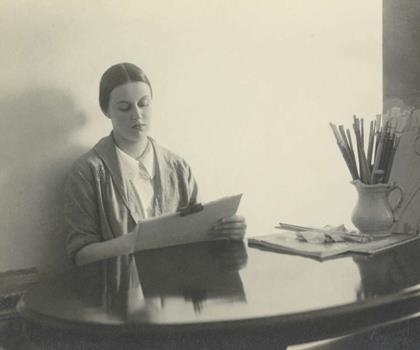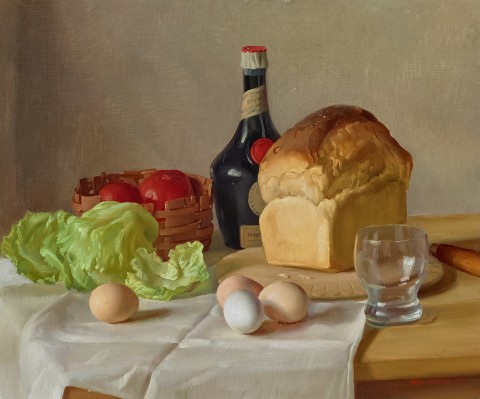STILL LIFE STUDY, 1931
NORA HEYSEN
oil on canvas
51.0 x 61.0 cm
signed and dated lower right: NORA. HEYSEN. 1931.
bears inscription verso: no. 40
Stephen Robert Delmont, Adelaide, acquired directly from the artist, c.1931
Thence by descent
Private collection, Adelaide
Thence by descent
Private collection, Adelaide
Autumn Exhibition of Paintings and Craftwork, S. A. Society of Arts, Adelaide, 23 April – 9 May
1931, cat. 64 (label attached verso, as ‘A Study’)
Nora Heysen, Society of Artists Gallery, Adelaide, 6 December 1933, cat. 41
Society of Arts', The Advertiser and Register, Adelaide, 23 April 1931, p. 11 (as ‘A Study’)
‘Fine Still Life Studies’, The Advertiser, Adelaide, 6 December 1933, p. 12
Cameron Wilson, S., From Shadow into Light. South Australian Women Artists Since Colonisation, Pagel Production, Adelaide, 1988, pl. 80, p. 62 (illus., as ‘Still Life’)
A Study, 1931, oil on canvas, 47.5 x 53.0 cm, Kerry Stokes Collection, Perth
210690.jpg

Painted when Nora Heysen was about twenty years old, Still Life Study, 1931 is a work of outstanding quality. Reflecting gifts inherited from her renowned father, Hans Heysen, who had a very formative influence on his talented daughter, it asserts her early rights to be honoured as one of Australia’s finest still-life artists. In a letter to Lionel Lindsay in 1927 Hans proudly announced: ‘we have another artist in the family!’1 Commenting on her ‘remarkable aptitude’, he wrote: ‘[she] can paint a very fair still life – true in tone values with a nice sense of colour in light’.2
For Nora, the thirties were a decade of extraordinary achievement. She won the South Australian Society of Arts Prize for Still Life in 1930, and the Trustees of the Art Gallery of New South Wales purchased her Petunias, 1930 from the annual exhibition of the Society of Artists, Sydney. It was her first work to enter a public collection. Two years later, Howard Hinton, the perceptive and generous art patron, gave the Sydney gallery her self portrait of 1932. His gifts to Armidale, now in the New England Regional Art Museum, included Heysen’s Still Life, 1933, gifted in 1933, and Eggs, 1927 in 1934. Moreover, the Queensland Art Gallery acquired its first Heysen in 1931, the still life A Mixed Bunch, 1930.
Aged just twenty-two, Nora held her first solo exhibition in 1933 at the South Australian Society of Arts, Adelaide. A sell-out, it included thirty still lifes, our painting among them. That same year she was awarded the Melrose Prize for Portraiture with Ruth, purchased soon after by the Art Gallery of South Australia, as well as the flower piece, Scabious, 1930. After some years of further study in London, Heysen returned to Australia in 1937. To top off the decade, in 1938 she became the first women to win the Archibald Prize with her portrait of Madame Elink Schuurman.
Still Life Study, 1931 is a major work from these early years. A companion painting, A Study, 1931, is in the prestigious Kerry Stokes Collection, Perth. Both are powerfully painted in a tonal realist style. Eye-catching form is developed through tone and light, which, in turn, highlights the textures. Smooth eggshells contrast with crumbly bread and crisp lettuce (in our painting only) and shiny glass surfaces. Red seals on elegantly inclined Benedictine bottles top traditional triangular compositions. When Still Life Study, 1931 was exhibited in Heysen’s solo show of 1933, the critic for the Adelaide Advertiser praised her still lifes, especially those portraying vegetables: ‘“Onions,” “Red Cabbage,” and “Still Life Study” are perfect in draughtsmanship and colour, especially the study of an ordinary loaf of bread, a few eggs and a lettuce!’3 Brightly lit from the left, Still Life Study, 1931 has a heightened sense of reality, clarity and stillness that is arresting. Nevertheless, the everyday objects of bread, cheese and eggs evoke domesticity - familiar produce from the kitchen and grounds of the Heysen home, ‘The Cedars’, in the Adelaide Hills outside Hahndorf, where Nora spent her early years.
1. Thiele, C., Heysen of Hahndorf, David Heysen Productions, revised edition, Adelaide, 2001, p. 221
2. Ibid
3. ‘Fine Still Life Studies’, The Advertiser, Adelaide, 6 December 1933, p. 12
DAVID THOMAS
